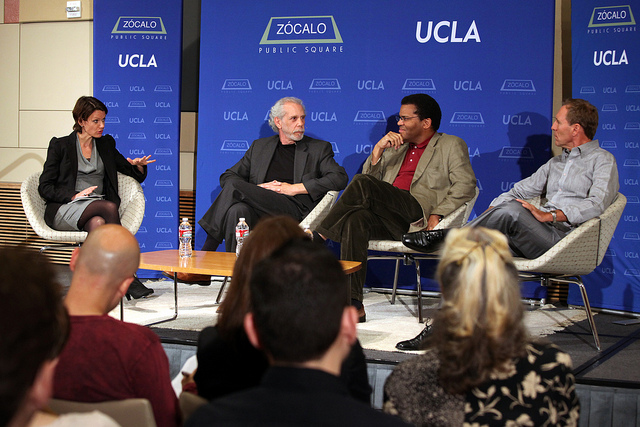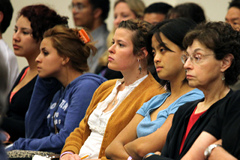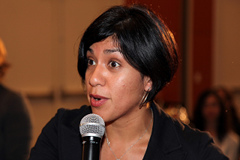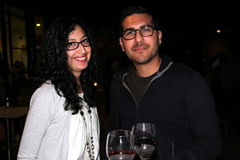
Documentary filmmaker Larry Adelman opened his remarks on a panel about health inequalities by emphasizing why the subject matters for him personally.
The issue is “not just that the rich on average will live more than six years longer in the United States than the poor,” he said. “Even middle-class white folks like me can expect to die two to three years sooner than the affluent. So this is about all of us, not just about the poor.”
That’s significant, Adelman said, because people need to focus on solving health inequality not just as charity, but because it affects their own lives. Adelman joined public health expert Tony Iton and urban planner Ryan Snyder on a panel moderated by KQED health reporter Sarah Varney to discuss the challenges posed by health disparities, as well as possible solutions to the problems.
The Scope of the Problem
 All three panelists at the event, which was co-sponsored by UCLA’s Luskin School of Public Affairs, referred to statistics about the breadth of health inequalities that stunned some audience members. Iton, senior vice president for the California Endowment, said the problem is particularly visible in Oakland, where he once served as director of the county health department.
All three panelists at the event, which was co-sponsored by UCLA’s Luskin School of Public Affairs, referred to statistics about the breadth of health inequalities that stunned some audience members. Iton, senior vice president for the California Endowment, said the problem is particularly visible in Oakland, where he once served as director of the county health department.
“A child growing up in west Oakland, an African-American child, can expect to live 15 years less long – 15 years – than a white child in the Oakland hills, just two or three miles away,” he said.
Varney opened the panel by asking Adelman to describe the famous Whitehall Study, which catalogued health disparities in Britain. Study participants were civil servants from all pay grades. The study, which is featured in Adelman’s documentary Unnatural Causes, showed a direct correlation between pay grade and health.
“When this began, this study, most of us [would have assumed] the people were dropping dead of heart attacks were high-powered executives” with high stress levels, he said. “Whitehall showed that not only was that not the case, the executives were living far longer than anyone.”
In Los Angeles, too, health disparities are dramatic, Snyder said, using the example of childhood obesity. In Manhattan Beach, one of the wealthiest areas of Southern California, about four percent of children are obese. In Maywood, a tiny working-class city in Los Angeles County, that figure is 37 percent.
Numerous Causes
 Too often, Adelman said, a person’s health problems are assumed to be solely their own fault.
Too often, Adelman said, a person’s health problems are assumed to be solely their own fault.
“People always say ‘Oh, some people are healthy because they eat right, they exercise, they don’t smoke, and others … are making wrong choices,’” he said. But “the choices we make are constrained by the choices we have. If you live downwind from a toxic dump, that’s not about your choice. If you don’t have a place to get those 5 to 7 vegetables per day in your neighborhood, that’s not a choice.”
The outside forces governing individuals’ health involve every issue of life, panelists said. Iton described the California Endowment’s work in 14 communities that face major public health challenges, saying despite their differences, the areas have many similar issues.
“The schools don’t work, they’re on the wrong side of the freeway, there’s no public transportation, there may even be environmental issues,” he said.
Snyder, who runs an urban planning consulting firm, said structural issues are a large part of the problem. He has consulted with over 100 cities to try to make communities healthier through access to transportation, bike lanes, walkable sidewalks and the like.
Snyder said that often, poor residents’ only choice for a place to live are communities that are not built in a healthy way.
“Skyrocketing rates of obesity are closely tied in with the built environment,” he said. For example, “access to park space is dramatically different in higher income neighborhoods versus lower income neighborhoods.”
One unifying element of the many factors that make people die earlier is the stress involved in being poor, Adelman said, invoking the “fight or flight response” that is common to all animals.
“What happens if you’re constantly on alert, constantly in a world that’s uncertain?” he said. “If your 401k might disappear, if you’re worried about whether your kid is safe at night … it actually wears down your organs.”
Implementing Solutions
 Although none of the panelists claimed to have all the answers to solving health inequalities, they all proposed partial solutions. Varney commended the California Endowment’s Healthy Communities initiative for addressing root causes rather than simply the surface issues.
Although none of the panelists claimed to have all the answers to solving health inequalities, they all proposed partial solutions. Varney commended the California Endowment’s Healthy Communities initiative for addressing root causes rather than simply the surface issues.
Much of Snyder’s work involves creating plans for communities to make them more walkable and bikeable, a major factor separating healthy, affluent neighborhoods from struggling poor ones.
“The public health folks are really leading the charge, not the planners, on these health issues,” he said.
Iton said that the public health community has only recently begun to put enough issue on preventative, rather than reactive, medicine. Education, he said, is a prime way to combat health problems that plague too many people.
“We’ve started to realize that health is really opportunity, the ability to get an education, to get a job, to really access the levers of opportunity of our society,” he said.
And all three panelists agreed that people looking to create healthier communities should look to the actual community members for answers. Snyder said that when he holds town hall meetings in poor neighborhoods, people turn out in droves, eager to share excellent ideas for how to improve their communities.
“Change is not going to start from the top down,” Adelman concluded. “It’s got to come from people demanding it from the ground up.”
For event photos, please click here.
For full video, please click here.
*Photos by Aaron Salcido




Send A Letter To the Editors